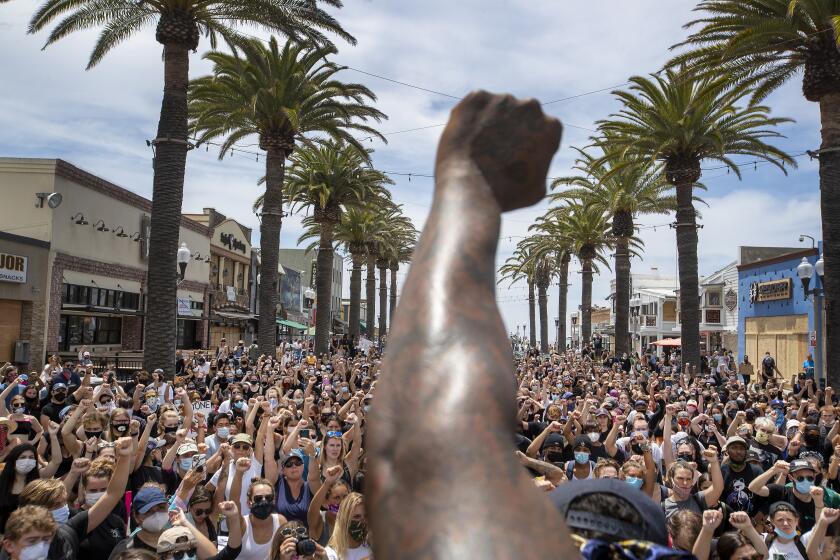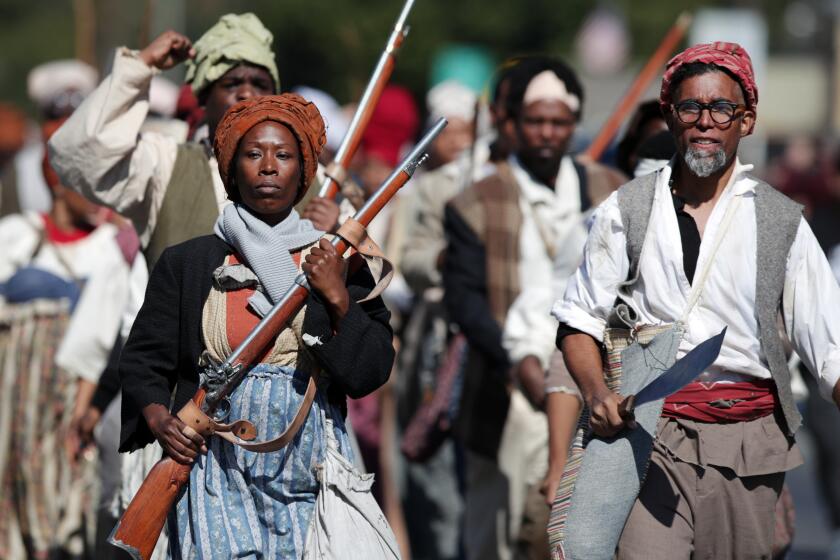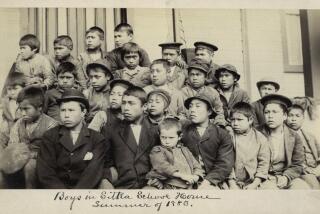Review: A rebel slave died a hero and was forgotten; a dramatic history revives his legend
- Share via
If you buy books linked on our site, The Times may earn a commission from Bookshop.org, whose fees support independent bookstores.
The bravest visionary you’ve never heard of may be a slave his owners called Coffij, who died more than 250 years ago in what is now Guyana.
Marjoleine Kars doesn’t come right out and say that; she’s too careful a scholar. But in “Blood on the River,” her epic history of a little-remembered slave rebellion, an admiration for Coffij comes through. More so than for the Dutch governor whose writings serve as a backbone for her story; more so than for the rebels who followed Coffij or the soldiers who defeated them.
An African who survived the middle passage and had to adapt to slavery in the rain forest, Coffij (written elsewhere as “Kofi” and “Cuffy”) led a slave rebellion that spread across a series of plantations up the Berbice River. He had a plan for how they would build a future after they took power from the owners and managers. The rebels held on for close to a year; the squabbling, starving and outmatched Europeans prevailed only with significant resources from abroad. Coffij never knew how close he came to winning.
Instead, Kars writes, “Coffij, the leader of the largest slave rebellion in the Caribbean to date, a man who dared to dream of a new colonial order, who, had he succeeded, might well have governed the first black republic, slipped out of history with barely a notice.”
That’s not the end of the story: The reason Kars can reconstruct the events is that the defeated rebels were tried in an ad hoc court, producing hundreds of pages of testimony that sat quietly in the Dutch National Archives for centuries. Kars, a native of the Netherlands and a history professor at the University of Maryland, Baltimore County, stumbled across the “extraordinarily rich” materials while researching in the archives. “We have few sources for the eighteenth century in which enslaved people actually speak,” she writes, “and here were their voices captured in old Dutch.”
Kars is transparent about the problematic nature of the testimonies, in which captured rebels were asked by a trio of hostile plantation owners about what transpired during the rebellion. In trying to save themselves, some committed rebels might say they’d been forced to fight; others might strategically lay blame (or credit) on those already dead or condemned.
Stephanie E. Jones-Rogers, winner of the Times Book Prize in history, spent a decade on “They Were Her Property,” about women slave owners.
Although the story is known in Guyana, Kars writes that formal European histories of the rebellion frame the story using the journal and letters of the local Dutch governor, Wolphert Simon van Hoogenheim; one 19th-century historian deemed the slave testimonies useless, because “the declarations of blacks can be but little trusted.” Kars has corrected that error and in the process created a sweeping, thoughtful narrative, joining a new wave of books that make visible previously dismissed Black voices, such as Erica Armstrong Dunbar’s “Never Caught: The Washingtons’ Relentless Pursuit of Their Runaway Slave, Ona Judge,” a finalist for the 2017 National Book Award.
By the time the Dutch established their first colony on the Berbice River in 1627, Spanish explorers and colonizers already had a long history on that stretch of Atlantic coast. They had created outposts, enemies and allies among the native populations, and the rival Dutch formed trading partnerships with the Arawaks that would be crucial to their survival.
The Dutch outposts were small, spokes extending from the banks of the Berbice and Canje rivers. Europeans found the jungles daunting and frequently deadly. Many died of fevers, probably yellow fever and malaria, others from “bloody flux” (dysentery); those who survived were plagued by mosquitoes, giant ants, piranhas, vampire bats, misery and misfortune.
It was not a place the officers of the Dutch West India Co. saw as a tropical paradise; they just wanted profit. They planted Caribbean crops — tobacco, sugar, cotton and coffee — and imported African slaves.
Enslaved people were forced to work in brutal conditions and in their spare time were expected to farm or fish to keep from starving. There were tales of maroons, escaped slaves and their families, successfully settling in the jungle, but survival was not guaranteed. The native tribes that allied with the Dutch often set up settlements just inland from the plantations and would be paid to return or execute any slaves who escaped.
About half of the dozens of plantations lining the rivers were connected to the company; the others were held by independent consortiums. Privately managed plantations were more prone to bad behavior, and it was at one of these that the revolt took root — blamed by Coffij and other leaders on the proprietor’s excessive cruelty.
Starting in early 1763, the rebellion spread swiftly from one plantation to the next. The settlement consisted of about 350 mostly Dutch plantation managers and their families and between 2,000 and 4,000 slaves. The self-liberated slaves took guns and goods; some killed their former masters. After driving them off, they dressed in their clothes and ate at their tables.
Those slave owners who survived were pushed to a handful of now-barren plantations near the mouth of the Berbice. The governor, Van Hoogenheim, wrote to his patrons immediately of their desperate prospects, but it would be months before his message reached home and reinforcements were sent. So begins Kars’ detailed reconstruction of the nearly year-long war between the rebelling slaves and the governor and his allies. She fills this long-ago conflict with tension, aided in part by the novelty of the story for many readers.
Walter Mosley, Luis Rodriguez, the coiner of #BlackLivesMatter and others sketch a hopeful future for L.A. and the U.S. after George Floyd protests.
What makes Coffij stand out is that he had a vision for the future. The rebelling slaves didn’t turn around and escape into the jungle; they held onto the plantations they captured because they intended to run them as owners. Coffij’s free nation would have borders and trade and make treaties; he suggested a partition plan, a diplomatic exchange that showed his savvy leadership.
Kars takes us through the push and pull of the long conflict. After being unseated as leader, Coffij committed suicide, an honorable choice in some African tribes, Kars writes. Coffij’s successors, Accara and Accabiré, scored military successes against new Dutch recruits until betrayed by an insider. When pushed back, the rebels dramatically torched each plantation as the Dutch came up the river, so they had to watch their assets burn. In their scorched-earth retreat, Coffij’s vision died too.
After the rebel forces were finally defeated, the hurried trials were devastating: If people saved themselves, they returned to a life of servitude; if they did not, they were burned at the stake, broken on the rack or hanged. The Dutch were so enamored with their torturous deaths that they created detailed drawings that are included in the book (and gave me nightmares). Of the 230 rebels on trial, 120 men and four women were executed.
Mostly, Van Hoogenheim, who was not one of the judges, just wanted the ordeal over — he just wanted the plantations back in business. And he wanted to go home.
Particularly fascinating to me were the stories on the edges of the conflict. How important was the woman at Coffij’s side who was described by the word that means either “cook” or “wife”? What of the white surgeon who was captured and/or cannily switched allegiances several times? When a handful of white soldiers joined the Black rebels, what was that like for all of them?
Actors recreate the 1811 German Coast Uprising, a slave rebellion that took place in Louisiana. New York performance artist Dread Scott organized the event, captured on film.
These are questions that fiction can answer but history cannot. What Kars does so well is tell this story in such a way that all the facts are in place, but many more stories might be imagined. Coffij emerges as the brilliant, tragic hero of a lost legend that happens to be true.
Kellogg is a former books editor of The Times.
Blood on the River: A Chronicle of Mutiny and Freedom on the Wild Coast
Marjoleine Kars
The New Press: 336 pages, $28
More to Read
Sign up for our Book Club newsletter
Get the latest news, events and more from the Los Angeles Times Book Club, and help us get L.A. reading and talking.
You may occasionally receive promotional content from the Los Angeles Times.









